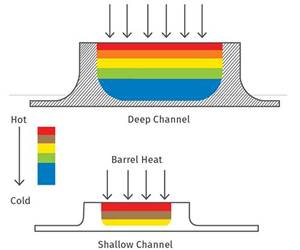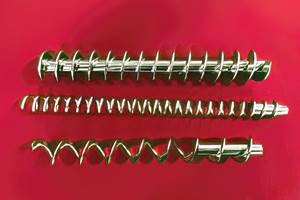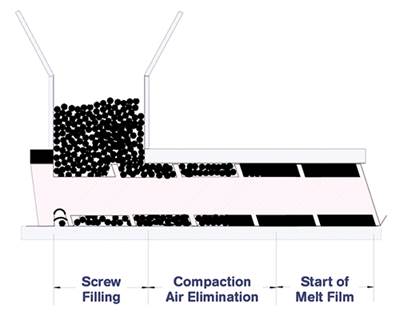EXTRUSION: What’s the Right Feed Throat Temperature?
Selecting the proper one is critical to the process.
In earlier columns I detailed the importance of the extruder feed throat design and how it affects both output and stability. Obviously nothing passes through the extruder that does not pass through the feed throat first, so its design is extremely important to the entire process.
So is feed throat temperature. It’s been noted that injection machine “extruders” often have higher specific output than extrusion extruders with the identical screw designs and discharge pressures. This is because injection molding machines do not utilize a separate feed throat. Instead, the barrel extends through the feed opening for strength reasons. As a result, the inner wall of the barrel at the resin entry point is usually much hotter than it is with an extruder having a separate feed throat.
The hotter inner surface on injection extruders increases the frictional drag between the barrel and polymer. There is a direct relationship between the barrel-to-polymer friction and output and often the output stability as well. Some extrusion extruders utilize the same concept. In those cases, specific output rates have been shown to improve 10-20%, depending on the polymer type, due to the greater and more rapid pressure development in the feed section.
In addition to improvements in output, a warmer feed throat can improve stability, particularly with polymers having low friction coefficients to metal and for high-temperature polymers. Surging occurs when the polymer adheres lightly to the barrel but then slips as the pressure in the feed area builds. This can result in an almost cyclic feed-rate variation that transfers all along the screw and results in a continuously varying output at the discharge.
If warmer feed throats improve output and stability, why are they not more popular in extrusion? Primarily because many extrusion processors worry about the polymer melting prematurely in the feed opening. This is certainly a valid concern to anyone who has experienced that situation. However, it is relatively rare and can be controlled with a cooling jacket (see illustration). It seldom occurs when the screw is turning, but rather when it is stopped. The same is true of polymer melting and sticking to the early feed flights of the screw.
During processing the incoming polymer continuously absorbs heat from the screw and feed throat, which keeps the metal cool enough to prevent it from melting the resin too soon. But remember that a screw is a machined steel bar, and when one end is kept hot the other end eventually will get hot too if there is nothing to extract the heat. Interestingly, the screw does not actually touch the feed throat because of additional radial clearance in that area, so cooling the feed throat has only a minor convective cooling effect on the screw temperature. If the screw temperature needs to be controlled, it’s best to utilize internal cooling channels.
Essentially all extruders have some means to cool their feed throats; water is typically used. The feed throat is cored so that water can be passed through it to control the temperature. Some processors have attempted a more precise control mechanism by metering the flow or by controlling the outlet temperature, or both. Although this can produce a workable solution, it is not a true control because the feed throat changes temperature with various processes and polymer characteristics, and metering the flow and controlling the outlet temperature are only part of the overall thermal balance.
There is also a general misunderstanding about the feed throat by operators. Many consider it as only a hole through which to introduce polymer to the screw, when in fact it’s the initial part of the barrel. As a result they incorrectly assume that if a little water is good then a lot is better, and they wind up losing a control variable and often reducing the extruder performance. The same can be said for internal screw cooling.
Excessive cooling can significantly affect power efficiency, as the early part of the screw and barrel are where it’s desirable to maximize the energy going into the polymer rather than extracting energy. To get the proper energy balance in the feed throat, each extruder will have its own “best” temperature, as the balance is affected by other variables such as screw speed, zone 1 setting, polymer characteristics, mass of the extrudate, etc. This “best” temperature must be found through trial and error by comparing specific output and stability (head pressure) as the coolant flow is adjusted. By adding a separate thermocouple in the feed throat with a temperature indicator, the proper setting during changing conditions can be much more quickly achieved once the ideal temperature is determined.
Related Content
NPE2024 Wrap-Up: Sustainability Dominates Show Floor News
Across all process types, sustainability was a big theme at NPE2024. But there was plenty to see in automation and artificial intelligence as well.
Read MoreThe Importance of Barrel Heat and Melt Temperature
Barrel temperature may impact melting in the case of very small extruders running very slowly. Otherwise, melting is mainly the result of shear heating of the polymer.
Read MoreWhat to Know About Your Materials When Choosing a Feeder
Feeder performance is crucial to operating extrusion and compounding lines. And consistent, reliable feeding depends in large part on selecting a feeder compatible with the materials and additives you intend to process. Follow these tips to analyze your feeder requirements.
Read MoreHow To Identify Resin Degradation in Single-Screw Extruders
Degradation can occur in many single-screw extrusion operations, and typically occurs due to minor design flaws in the screw. Here is how to track it down.
Read MoreRead Next
Don’t Overlook the Feed Section
Most extrusion screw designers often do not design the feed section with the same rigor as other sections. This is odd since nothing goes through the screw that doesn’t first go through the feed section.
Read MoreFor PLASTICS' CEO Seaholm, NPE to Shine Light on Sustainability Successes
With advocacy, communication and sustainability as three main pillars, Seaholm leads a trade association to NPE that ‘is more active today than we have ever been.’
Read MoreBeyond Prototypes: 8 Ways the Plastics Industry Is Using 3D Printing
Plastics processors are finding applications for 3D printing around the plant and across the supply chain. Here are 8 examples to look for at NPE2024.
Read More.jpg;width=70;height=70;mode=crop)














